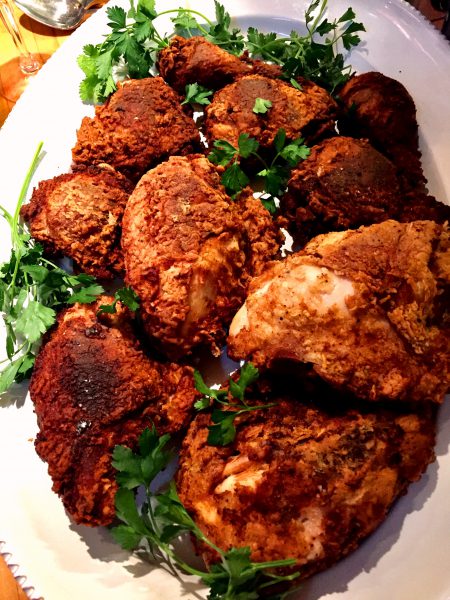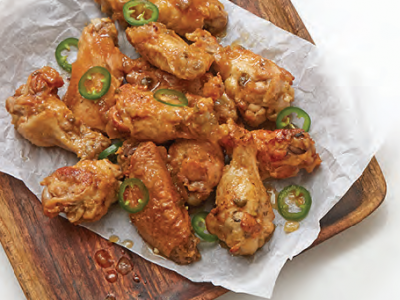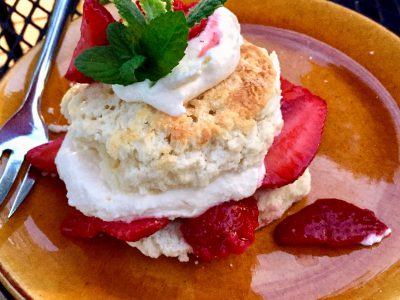Buttermilk-Bathed Pan-Fried Chicken
From American Home Cooking. Click to find this and Cheryl’s complete collection of Exciting Cookbooks
Fried chicken rules the roost when it comes to American chicken specialties. Nothing is more popular, even in an age that is afraid of frying, and nothing is tastier when it is fried well. Mary Randolph provided the first recipe in The Virginia Housewife (1824), but as she knew, it worked well only with tender young chickens, which few people could afford to sacrifice from their egg-producing responsibilities. Fried chicken began its ascent into national prominence in the late nineteenth century, after the introduction of the range improved the control of frying temperatures, and gained icon status a few decades later when commercial chicken raised for meat became cheaper and more plentiful. As Laurie Colwin says about her recipe in Home Cooking(1988), everyone knows there is only one right way to fry chicken, but they happen to be wrong in thinking that it’s their way. This is our approach, honed over many years of making and munching.
SERVES 4 TO 6
CHICKEN
Approximately 3 cups buttermilk
2 to 3 teaspoons hot pepper sauce, such as Texas Pete or Tabasco
2 to 3 teaspoons salt
3½- to 4-poundchicken, preferably a roaster, cut into 8 bone-in serving pieces
1½ teaspoons freshly milled black pepper
1 teaspoon dry mustard
2 cups unbleached all-purpose flour Approximately1½ pounds (3 cups)
Approximately 1½ pounds (3 cups)lard or l ½ pounds Crisco or other solid vegetable shortening plus 3 tablespoons bacon drippings
CREAM GRAVY
Pan drippings
3 tablespoons seasoned flour
12-ounce can evaporated milk
1 cup chicken stock, preferably homemade
3 tablespoons whipping cream or half-and-half
½ teaspoon freshly milled black pepper or more to taste
Salt
- Mix the buttermilk, as much hot pepper sauce as you like, and 1 teaspoon of the salt in a shallow Add the chicken parts, turning to coat them well. Cover and refrigerate for at least2 hours and up to12 hours, turning occasionally.
- Combine the remaining 1 to 2 teaspoons salt, pepper, dry mustard, and flour in a large plastic bag or in the time-honored brown paper grocery sack. Place a wire rack for draining the chicken near the cooking area.
- Melt the lard or shortening in a12-inch to 14-inchcast-iron skillet over medium high If using shortening, then add the bacon drippings to the skillet. When the lard or shortening reaches 375°F, reduce the heat to medium and begin to prepare the chicken.
- Starting with the dark meat and ending with the breasts, lift the chicken pieces, one by one, out of the marinade, letting excess liquid drain back into the Drop each chicken piece into the seasoned flour and shake to coat it. Place each in the skillet, skin side down. The pieces should fit snugly together in a 12-inch skillet, although they shouldn’t stick to each other. Quickly adjust the heat as needed to maintain a temperature of about 300°F (adding all of the chicken to the oil should have dropped the temperature to this degree already). Cover the skillet and fry for 16 minutes, resisting the urge to open the skillet. You should hear a constant ongoing bubbling and sizzling, neither urgent nor lackadaisical. After the allotted time, remove the lid and tum the chicken with tongs, using light pressure to avoid piercing the crust. Fry uncovered for 15 to 17 additional minutes, until the now crackling crust is a rich golden brown and the meat is cooked through but still juicy. Drain the chicken on the rack.
- Prepare the gravy, pouring off the pan drippings through a strainer and leaving about ¼ cup of the drippings in the Return any brown cracklings from the strainer to the skillet and discard the remaining drippings. Return the skillet to medium heat. Whisk in the flour, stirring to avoid lumps. Slowly add the evaporated milk, stock, and cream, whisking as you pour them in. Bring to a boil, then simmer until the gravy is thickened and the raw flour taste is gone, about 3 minutes. Stir the gravy up from the bottom frequently, scraping up the browned bits. Add pepper and salt to taste, keeping in mind that the pepper should be pronounced but pleasant on your tongue. Transfer the gravy to a gravy boat and the chicken to a platter. Serve immediately.
- TECHNIQUE TIP: Don’t bother with fried chicken unless you’re committed to perfection in the pan. Start with the finest chicken you can find, avoiding ordinary supermarket poultry parts. Find a good meat market that takes pride in its chickens, and buy a whole bird, for the butcher or you to cut into parts. Soaking the chicken in buttermilk adds moisture as well as tang, so don’t skimp on the Fry in a hefty cast-iron skillet, eschewing anything with an electric cord or a designer color. Never cook the chicken in more than½ inch of oil or you will be deep-frying rather than pan-frying, and will lose the optimum balance between a crispy exterior and juicy interior. In the unlikely event of leftovers, eat fried chicken cold, which tastes much better than a reheated encore.



